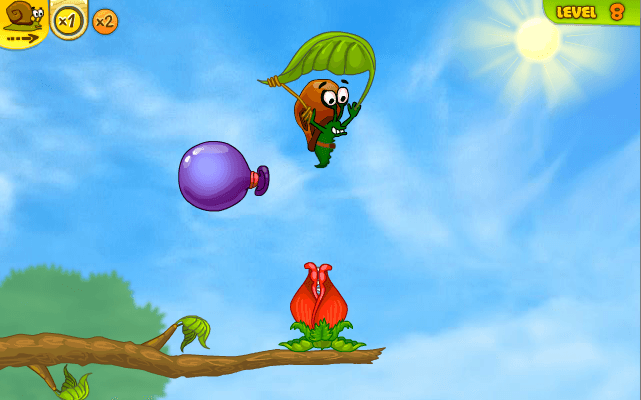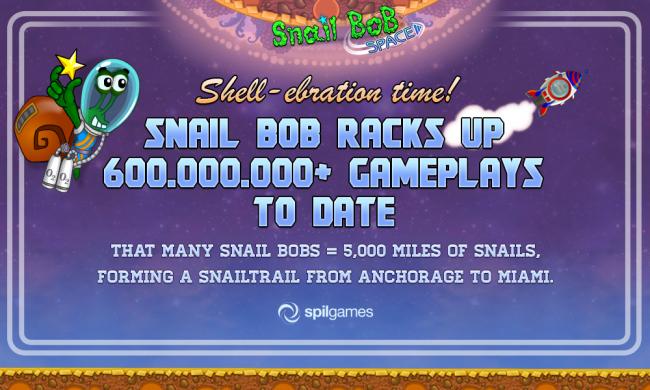- Wondering how to get Monopoly GO! free rolls? Well, you’ve come to the right place. In this guide, we provide you with a bunch of tips and tricks to get some free rolls for the hit new mobile game. We’ll …
Best Roblox Horror Games to Play Right Now – Updated Weekly
By Adele Wilson
Our Best Roblox Horror Games guide features the scariest and most creative experiences to play right now on the platform!The BEST Roblox Games of The Week – Games You Need To Play!
By Sho Roberts
Our feature shares our pick for the Best Roblox Games of the week! With our feature, we guarantee you'll find something new to play!All Grades in Type Soul – Each Race Explained
By Adele Wilson
Our All Grades in Type Soul guide lists every grade in the game for all races, including how to increase your grade quickly!
Sometimes having no game plan can pay off: The story of Snail Bob
Developing Snail Bob, a casual web and mobile game for families and kids, was a risky endeavor in hindsight. We had no specific theme plan at the beginning of the franchise. Instead we let a free flow of creativity lead us as we designed the game. It turned out that the random variety endeared players and built fans, but for us as developers, we quickly learned how much more work we had bitten off for ourselves.

How it began: We started by creating a short prototype of our new character, Snail Bob, crawling by himself. It was really funny, but we still needed to know more about how players could interact with him. Initially we wanted to give players the opportunity to drag physical objects, but after creating the prototype we discovered that dragging those objects made the gameplay too difficult. We made changes so players could control Bob using different levers, buttons and other tools in order to get him to finish each level.This resulted in an unusual mix between physics, puzzle and point-and-click games. The levels were all quite different.
We created a number of unique animations per character per level, with the goal of delivering variety and surprises for players. This of course demanded unique code for each behavior; and often that code is used only once in a game session. Like cartoons of the old days when an artist drew 24 pictures for one second in a cartoon, we could spend several days on one level that the player completes in a single minute.

Developing Snail Bob, a casual web and mobile game for families and kids, was a risky endeavor in hindsight. We had no specific theme plan at the beginning of the franchise. Instead we let a free flow of creativity lead us as we designed the game. It turned out that the random variety endeared players and built fans, but for us as developers, we quickly learned how much more work we had bitten off for ourselves.
How it began: We started by creating a short prototype of our new character, Snail Bob, crawling by himself. It was really funny, but we still needed to know more about how players could interact with him. Initially we wanted to give players the opportunity to drag physical objects, but after creating the prototype we discovered that dragging those objects made the gameplay too difficult. We made changes so players could control Bob using different levers, buttons and other tools in order to get him to finish each level.This resulted in an unusual mix between physics, puzzle and point-and-click games. The levels were all quite different.

We created a number of unique animations per character per level, with the goal of delivering variety and surprises for players. This of course demanded unique code for each behavior; and often that code is used only once in a game session. Like cartoons of the old days when an artist drew 24 pictures for one second in a cartoon, we could spend several days on one level that the player completes in a single minute.
The feedback from fans about the various experiences they enjoyed in each level kept us going (and working!). By the third and fourth chapters of the franchise, we were creating the game using Flash. That’s when it became very clear to us that making unique levels increased the development time to an unacceptable level.
So we made changes in following versions of the franchise. We programmed many different game objects. We placed these objects on levels, combined them, and wound up with a large variety between levels. Our ready-to-use game objects were so different from each other that players still felt like each level was unique. As a result, we could finally use the level editor in full force. The reduction in programming time was considerable.
However, we didn’t go all the way. We are now using a combined approach of standardized game levels and unique elements. By retaining humor and unexpected animations in some levels, we have been able to keep players emotionally tied to the game. This combined approach allows us to keep our creativity without sacrificing development time.

After seeing more than 600 million game plays in the franchise to date, we have experienced growing pains along with fan support. Our key learnings include:
- If you have the time and you’re patient, create many game levels that are unique. Players notice it and like it. It’s like handmade items. They contain a bit of the soul of the person who made them. But if you want to reduce your time and still tie players to your game, use the combined approach: many pre-programmed game objects on each level combined with unexpected unique objects and animations. Find a balance that works for you. That way as players go through the entire game they won’t become bored as they would with a game using a “factory” approach.
- One of the key things that has helped our game get in front of people worldwide are smart publisher partnerships. Just as important is the help they give us in translating the game into key languages. Publishers have been bringing our game to their large audiences and have made it a recognizable brand worldwide. It has allowed us go to other platforms because people already know about our game. Marketing support per publisher is imperative as well; and each publisher will handle marketing in ways that support their audiences. Publisher Spil Games has taken a lighthearted approach in its marketing of Snail Bob. The company shares fun stats with consumers about the snail, including how he dies! Building that connection with players drives loyalty and increases their game play time.
We now have a game plan for Snail Bob. We’ve found a balance and we’re aware of how much unique elements in a level will increase our development time. Alas, however, we can’t help ourselves and we still experiment with random creativity. We now have an extremely clear idea of how much time we need to set aside for the extra development. We just need to temper ourselves and keep our eye on the right balance between our work load and creativity.
Andrey Kovalishin cofounded the Hunter Hamster Studio with Maxim Yurchenko, which develops the Snail Bob franchise, in 2010. The studio is located in Bryansk, Russia.
More articles...
Monopoly GO! Free Rolls – Links For Free Dice
By Glen Fox
Wondering how to get Monopoly GO! free rolls? Well, you’ve come to the right place. In this guide, we provide you with a bunch of tips and tricks to get some free rolls for the hit new mobile game. We’ll …Best Roblox Horror Games to Play Right Now – Updated Weekly
By Adele Wilson
Our Best Roblox Horror Games guide features the scariest and most creative experiences to play right now on the platform!The BEST Roblox Games of The Week – Games You Need To Play!
By Sho Roberts
Our feature shares our pick for the Best Roblox Games of the week! With our feature, we guarantee you'll find something new to play!All Grades in Type Soul – Each Race Explained
By Adele Wilson
Our All Grades in Type Soul guide lists every grade in the game for all races, including how to increase your grade quickly!







